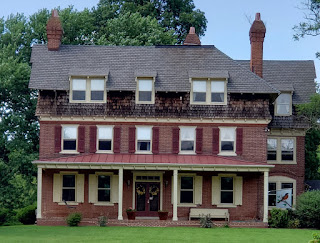Delaware City: A Treasure Trove of Greek Revival Architecture
We started our tour of the Delaware Bayshore Byway this past weekend with a quick drive through Delaware City, checking out just a handful of the many amazing historic buildings there.
Delaware City's history is inextricably linked to the Chesapeake & Delaware Canal. The city was laid out in 1826, when the C&D Canal was being completed, to serve ships and passengers traveling the canal between the Delaware and Chesapeake Bays. It was envisioned as a true city, hence the name, with Clinton Street a wide boulevard named after the founder of the Erie Canal.
The oldest building we saw was Fairview, 701 Cox Neck Rd, built for a landowner around 1822, so it’s older than Delaware City. The third story and chimneys were added around 1885 by Frank Furness, a highly regarded Philadelphia architect whose designs include the Wilmington train station and the Old Library in New Castle. To our eyes, the third story doesn’t fit with the rest of the house, showing that even the best architects don’t always get things right!
 |
| Fairview |
The Central Hotel and Sterling Tavern, 85 Clinton Street, was one of the first buildings, constructed around 1830 in the Federal style. Originally a grain warehouse, it became a summer resort in the early 1900s. Today it's the home of the American Birding Association.
 |
| Central Hotel |
Until about 1880, Delaware City grew and prospered, not only with business from the canal but also from fishing and nearby peach farms. Greek Revival was the most popular American architectural style during this time, so it should be no surprise that it was popular in Delaware City.
Today Delaware City has the best collection of vernacular (everyday, not upscale) Greek Revival buildings in Delaware. Greek Revival buildings are inspired by ancient Greek temples, so their features mimic Greek temples’ relatively flat roofs, pillars, and simple lines. Greek temples didn’t have round or arched windows, so neither do Greek Revival buildings. Greek temples also didn’t have visible chimneys, so Greek Revival chimneys are small and unobtrusive.
One Greek Revival example is the Delaware City National Bank at 122 Washington Street, built around 1849. The bank manager lived on the upper floors. The large, tall windows are another characteristic of Greek Revival architecture. The short windows on the third floor are another hallmark of Greek Revival architecture. They're called lay-on-your-belly windows--because you'd have to lay on the floor to look out them--or frieze-band windows, because they're part of a wide under-the-roof band that's reminiscent of the wide decorative frieze bands under Greek temple roofs.
 |
| Delaware City National Bank |
Another Greek Revival example is the John Ash House or Belville House at 110-112 Washington Street, built around 1850. The rectangular sidelight and transom windows around the door are more hallmarks of Greek Revival architecture. Dr. Belville, a prominent physician, lived there. The one-story brick addition was a doctor's office, added around 1895, and there's a one-story frame addition that was a pharmacy added around 1900. I've read that a hitching post and carriage block are still there, but during our brief stop (it was really hot), we didn't see them.
 |
| John Ash House or Belville House |
A really interesting house is the Captain George Maxwell House at 122 Adams Street, built around 1850 and described as a mix of Italianate and Greek Revival. Maxwell was a steamboat captain and first president of Delaware City National Bank. The house is supposed to have features designed to resemble a ship, but I didn't see any.
 |
| Captain George Maxwell House |
One of my favorite buildings so far in Delaware City is the adorable Christ Episcopal Church at 222 Clinton Street, built 1848-51 in Gothic Revival style.
 |
| Christ Episcopal Church |
Another of my favorites so far is Chelsea at 910 5th Street, built for a peach farmer around 1848 in what’s called an Italianate/Greek Revival style. There were a number of peach farmers around Delaware City. One built a house in this distinctive style. The other peach farmers liked it and built their own houses in the same style, and the houses became known as “peach mansions.” This is the only one left in this area.
 |
| Chelsea |
Delaware City has many other interesting historic buildings (250 in its Historic District) plus a waterfront walkway, so we’ll definitely come back when it’s cooler to explore more.
UPDATE 10/31/2020: My new blog post on Magnolia has more information on Delaware's largely-vanished peach industry.



Linda, Great pictures and very interesting details on the architecture of Delaware City! I had no idea you were such an "architecture history buff!" I never tire of looking at OLD houses in DE and PA. We've been exploring Media and surrounding areas. Rose Valley is so beautiful and Rose Valley Rd. was a fun surprise with a row of what looks like mill workers stone homes and an old mill used as a wedding venue. I need to look into that.
ReplyDeleteI will enjoy following your blog, you're such a good writer! This will be great fun and get more of us out exploring areas and history close by! Renee
Thank you, Renee! We will add Delaware County PA to our backroads exploration list! I grew up in the Philly suburbs and love all the stone houses in and around the city.
Delete